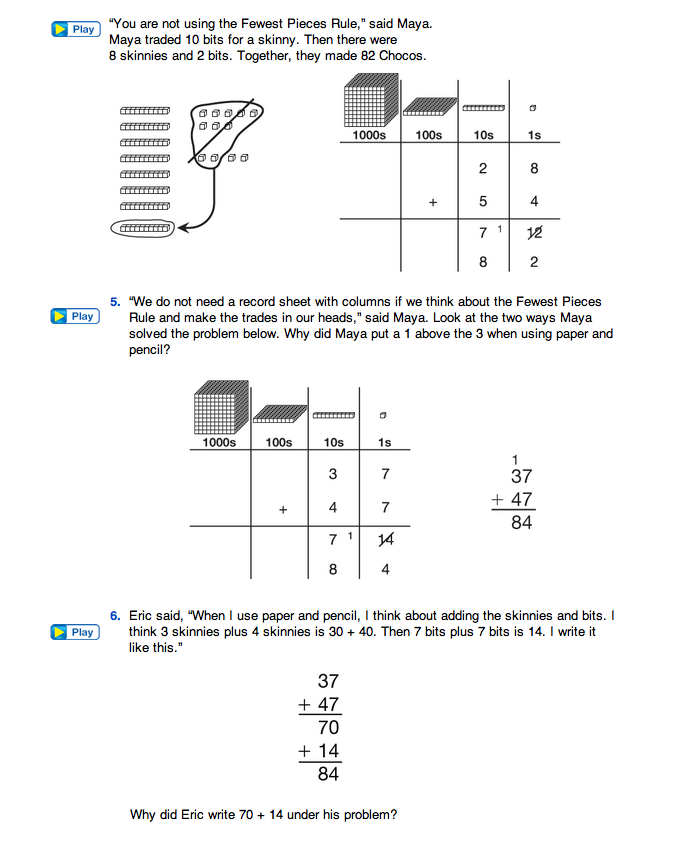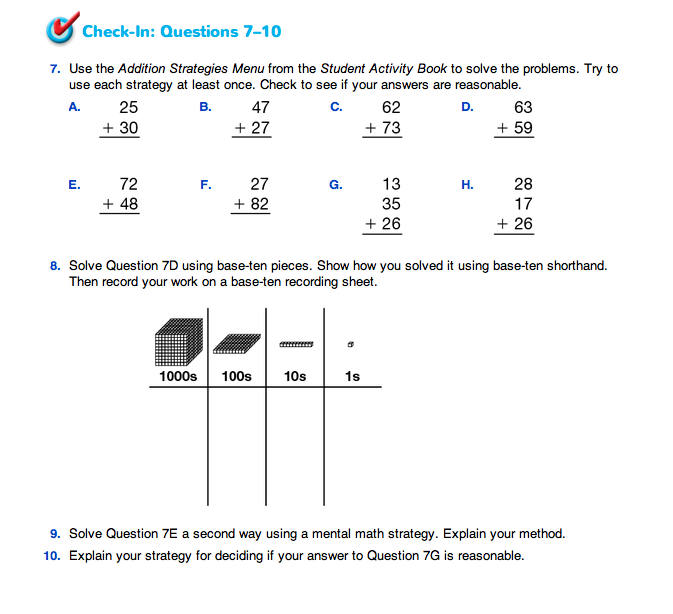Ask students to read the problem in the first two paragraphs of the Addition with Base-Ten Pieces section of the Addition Review pages in the Student Guide and study the picture.
- Is 78 Chocos a reasonable answer for the number of Chocos that Eric and Maya made on Monday? Why or why not? (Possible response: Yes. You can just add the tens and ones in your head. 40 + 30 = 70, 2 + 6 = 8, and 70 + 8 = 78.)
- Does Eric need to make any trades to show the Fewest Pieces Rule? (No)
After students read and study the second problem on the page, ask:
- What does the 7 in the problem stand for? (The total number of skinnies.)
- How many Chocos is that? (70 Chocos)
- What does the 12 stand for? (The total number of bits.)
- Do the numbers at the bottom of the column show the Fewest Pieces Rule? If not, what trades can be made? (No, you can trade ten bits for a skinny.)
See Maya's trades at the top of the next page in the Student Guide and discuss her work.
Then ask students to discuss Question 5 in pairs and decide on an answer. Discuss the problem as a class.
- When Maya solved the problem using paper and pencil, what trade did she make in her head? (She traded ten bits [ones] for one skinny [ten].)
- Why did Maya put a 1 above the 3 when using paper and pencil? (Possible response: She put a 1 above her 3 because she ended up with 14, so she put a 1 in the tens place because she can't have 14 in the ones place.)
- Is Maya's answer reasonable? How do you know? (Yes. Possible response: 30 + 40 is 70 and 7 + 7 is more than 10, so it is reasonable.)
- Is Maya's strategy represented on the Addition Strategies Menu? (Yes. It is like Julia's Compact Method.)
Discuss Question 6.
- What did Eric add to get the 70? (He added the 3 tens and the 4 tens. That's the same as 30 + 40.)
- What base-ten pieces represent the 70? (7 skinnies)
- What did he add to get the 14? (He added the ones.)
- What base-ten pieces represent the 14? (bits)
- Why didn't Eric have to make any trades? (He thought of the 7 skinnies as 70 and added on the 14 to get 84—84 already uses the Fewest Pieces.)
- Is Eric's strategy represented on the Addition Strategies Menu? (Yes. It is like Josh's All-Partials.)
Tell students to use their Addition Strategies Menu as they complete Check-In: Questions 7–10 in the Student Guide.
Use Check-In: Questions 7–10 in the Student Guide and the corresponding Feedback Box Assessment Master to assess students' progress on the following Expectations:
- Solving addition problems using base-ten pieces [E2].
- Adding using mental math strategies [E3].
- Adding using all-partials or the compact methods [E4].
- Estimating sums using mental math strategies [E5].
- Checking for reasonableness [MPE3] and showing your work [MPE5].
Use the Workshop in Lesson 6 to provide targeted practice.















